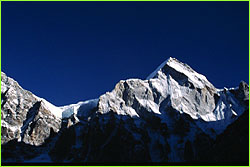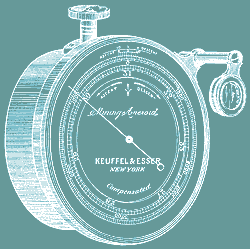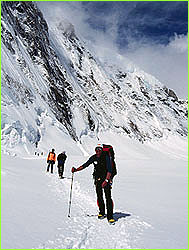

|

|
|
|
|
|
 Pressure on Earth
Pressure on EarthA version of this article first appeared on NOVA's Web site Everest. Put Mt. Everest (28 deg North) at the latitude of Mt. McKinley (63 deg North) in the United States and it is likely that no climber would ever have been able to reach the summit breathing the natural air. Everest would feel, physiologically, as if it were an additional 3,000 feet higher. The air would be so thin that even the best climber would have no choice but to use supplemental oxygen. Why? Because of the many factors which affect atmospheric pressure. Pioneering scientists discovered atmospheric pressure (also known as barometric or air pressure) in the 17th century, and determined a startling new fact -- that air actually has weight. Evangelista Torricelli, one of the first to discover atmospheric pressure, once said, "We live submerged at the bottom of an ocean of the element air." The Earth's gravitational field is pulling on air, and this pull, or "pressure" of air, is called atmospheric pressure. Toriccelli also went on to develop the mercury barometer, an instrument used to measure atmospheric pressure. A barometer also monitors variations in atmospheric pressure. As air becomes thinner, the density of air decreases, and so too does the pressure of air.  Many different factors affect the density of air. Most measurably,
as altitude increases, air becomes less dense, decreasing
atmospheric pressure. Standard altitude-pressure tables allow
mountaineers and aviators to determine their approximate height by
measuring atmospheric pressure. This relationship also works
inversely. The height of a mountain determines, approximately, the
density of air on its summit. As air becomes less dense, it contains
less gases per unit of volume, and therefore less oxygen.
Physiologists use this information to predict the oxygen deprivation
a mountaineer faces at high altitude.
Many different factors affect the density of air. Most measurably,
as altitude increases, air becomes less dense, decreasing
atmospheric pressure. Standard altitude-pressure tables allow
mountaineers and aviators to determine their approximate height by
measuring atmospheric pressure. This relationship also works
inversely. The height of a mountain determines, approximately, the
density of air on its summit. As air becomes less dense, it contains
less gases per unit of volume, and therefore less oxygen.
Physiologists use this information to predict the oxygen deprivation
a mountaineer faces at high altitude. For the most part, this relationship works quite well. But factors other than altitude also effect the density of air. For one thing, water molecules have less mass than other gas molecules in air; so as water vapor increases, the density of air decreases. Temperature also changes the density of air. As air gets warmer it expands and becomes less dense, causing atmospheric pressure to fall. In addition, air within the atmosphere can rise and fall, changing the atmospheric pressure. In fact, meteorologists monitor atmospheric pressure at the Earth's surface in order to determine whether the pressure is rising or falling, which helps to predict weather patterns.  High pressure often represents stable air, while low pressure can
signify instability. On a cold, sunny day there will be a
significantly higher atmospheric pressure than when a big storm is
moving in on a hot and humid day.
High pressure often represents stable air, while low pressure can
signify instability. On a cold, sunny day there will be a
significantly higher atmospheric pressure than when a big storm is
moving in on a hot and humid day. But the density of the atmosphere varies at different points around the globe as well. At the poles, the atmosphere is much thinner than at the equator. Because of these variations, two mountaineers climbing at the same altitude but on different mountains could experience different atmospheric pressures and therefore different physiological effects. One climber might have no trouble breathing, while the other can barely pull in enough oxygen to survive. The small amount of oxygen on the top of Everest puts this peak near if not at human's physiological limit. And this is why Everest, if it were at a higher latitude, could very well be beyond the physiological limits of someone trying to climb without oxygen. Climb | Expedition | Mountain of Extremes Denali for Kids | Dispatches | E-Mail | Resources Site Map | Surviving Denali Home Editor's Picks | Previous Sites | Join Us/E-mail | TV/Web Schedule About NOVA | Teachers | Site Map | Shop | Jobs | Search | To print PBS Online | NOVA Online | WGBH © | Updated November 2000 |
|